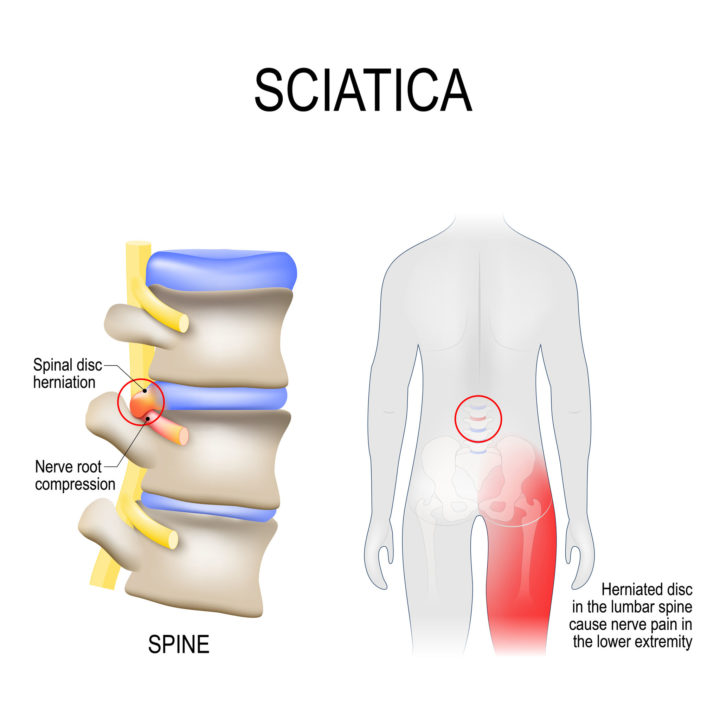Sciatica Pain Massage
What is Sciatica?
Sciatica is actually a collection of conditions that share a common symptom: pain, numbness, sensitivity, and/or weakness that runs down the leg posterolaterally (i.e. down the back of the leg more toward the outer side). It’s common. Since we humans are all unique with different lifestyles, skeletons, and activity levels, the nature of the pain varies from person to person. Massage Therapy can facilitate sciatic nerve pain relief, though ideal treatment incorporates manual therapy AND physical therapy/corrective exercises.
What causes sciatica nerve pain?
Sciatic pain is caused by pressure on the sciatic nerve. The sciatic nerve is a thick bundled nerve that exits the lumbar spine (low back) and runs down the back of the leg. It weaves through the sacrum, the hip muscles, and the hamstrings before it splits at the knee joint into 2 nerves that continue to run down the leg into the ankle and foot. The sciatic nerve is like an electrical wire that connects the spinal cord to the leg. It’s important for powering muscles in the thigh, leg and foot, and for providing skin sensation. There are a few major points along the path where the body can put undue pressure on the nerve to cause ‘sciatic’ pain.
These sites are:
- At the spine:
- protruding or herniated disc can press on the nerve as it exits the spine.
- narrowing of the spinal canal that spinal nerves travel through can impinge the nerve.
- In the hip: The sciatic nerve runs underneath the deep hip rotator muscles. These muscles, especially the piriformis muscle can press on the nerve if the hip is out of alignment and/or the muscles surrounding the hip are out of balance.
- Anywhere along the nerve’s path. Myofascial restrictions from the low back down to the ankle can exacerbate sciatic pain.
Can massage therapy be used for sciatica nerve pain relief?
Yes. No guarantees. But, massages for sciatica can provide sciatica pain relief by decompressing the areas that are irritating the nerve. Careful treatment to the myofascia of the low back, hip, hamstrings, and calves is key since tightness or restriction in these areas is often a cause AND an effect of sciatic neural tension. Targeted soft tissue techniques like nerve flossing and Active Release Technique (ART) can help to relieve neural tension by freeing up the nerve from surrounding adhesions, though not all massage therapists are trained in these techniques.
Bottom line, a few sessions of simple massage therapy to the low/mid-back, hips, and legs may be enough to get rid of the tension that ignited the episode. Trigger point therapy to the gluteus medius (a lateral hip muscle) is also helpful since trigger points there often mimic and/or exacerbate sciatic pain. Be careful with self-stretching. Stretching may feel like it’s what you need, but improper stretching can make sciatic pain worse. Always make sure that your massage therapist does a full assessment and takes a full history before treating you.
Pain relief is the primary goal of massage therapy for any condition. In addition to easing muscle tension, massage therapy modulates the nervous system to cancel out pain responses and activates the parasympathetic nervous system to help control stress and general tension. It also brings much-needed awareness to help reconnect our mind, body, and spirit. And it just feels good.
Sometimes time, rest, gentle movement (ie walking), and massage therapy are the answer to mild sciatic pain. However, if the sciatic pain is chronic and not getting better with rest and time, it’s important to see a Doctor, Chiropractor, or Physical Therapist. They can do a full assessment and diagnose the root cause of your sciatic pain. In addition to soft tissue work, they will prescribe an individualized corrective exercise plan to address underlying faulty movement mechanics that contribute to your condition.
If your experiencing sciatica nerve pain and wish to know what sciatica treatment works for you, give us a call or tell us more using the form below.
